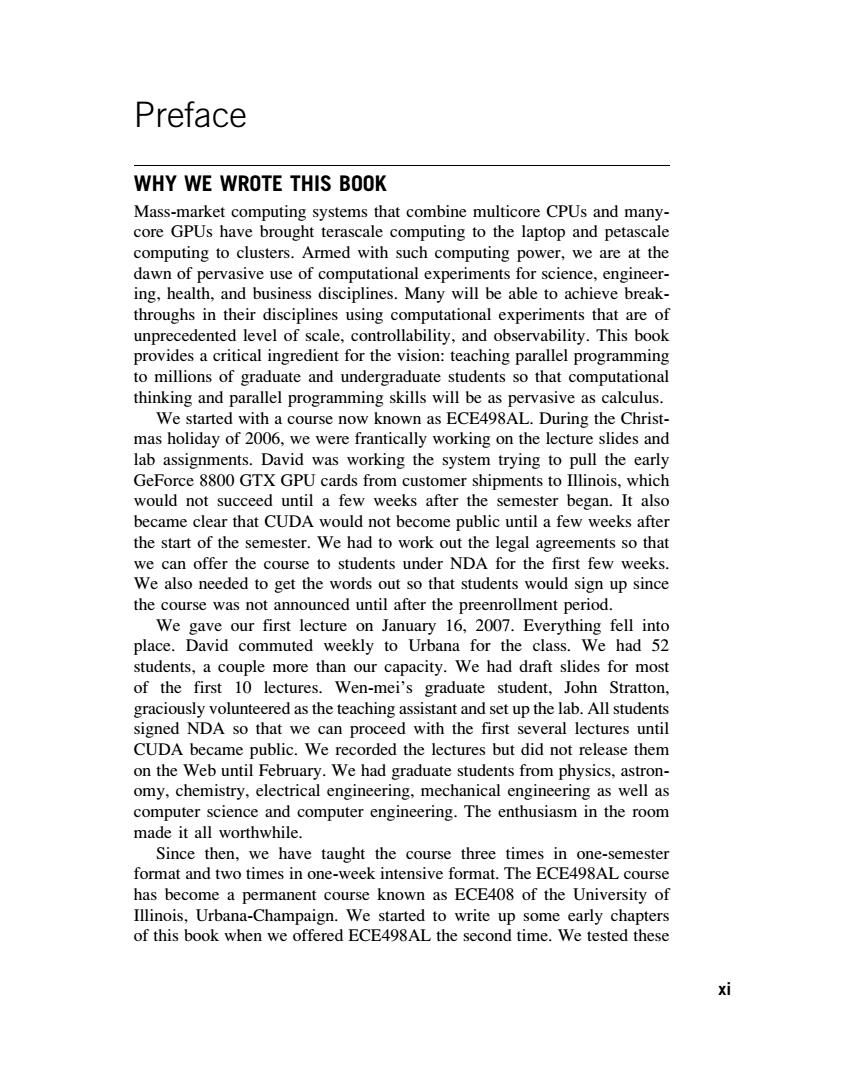正在加载图片...

Preface WHY WE WROTE THIS BOOK Mass-market computing systems that combine multicore CPUs and many- core GPUs have brought terascale computing to the laptop and petascale computing to clusters.Armed with such computing power,we are at the dawn of pervasive use of computational experiments for science,engineer- ing,health,and business disciplines.Many will be able to achieve break- throughs in their disciplines using computational experiments that are of unprecedented level of scale,controllability,and observability.This book provides a critical ingredient for the vision:teaching parallel programming to millions of graduate and undergraduate students so that computational thinking and parallel programming skills will be as pervasive as calculus. We started with a course now known as ECE498AL.During the Christ- mas holiday of 2006,we were frantically working on the lecture slides and lab assignments.David was working the system trying to pull the early GeForce 8800 GTX GPU cards from customer shipments to Illinois,which would not succeed until a few weeks after the semester began.It also became clear that CUDA would not become public until a few weeks after the start of the semester.We had to work out the legal agreements so that we can offer the course to students under NDA for the first few weeks. We also needed to get the words out so that students would sign up since the course was not announced until after the preenrollment period. We gave our first lecture on January 16,2007.Everything fell into place.David commuted weekly to Urbana for the class.We had 52 students,a couple more than our capacity.We had draft slides for most of the first 10 lectures.Wen-mei's graduate student,John Stratton, graciously volunteered as the teaching assistant and set up the lab.All students signed NDA so that we can proceed with the first several lectures until CUDA became public.We recorded the lectures but did not release them on the Web until February.We had graduate students from physics,astron- omy,chemistry,electrical engineering,mechanical engineering as well as computer science and computer engineering.The enthusiasm in the room made it all worthwhile. Since then,we have taught the course three times in one-semester format and two times in one-week intensive format.The ECE498AL course has become a permanent course known as ECE408 of the University of Illinois,Urbana-Champaign.We started to write up some early chapters of this book when we offered ECE498AL the second time.We tested these xiPreface WHY WE WROTE THIS BOOK Mass-market computing systems that combine multicore CPUs and manycore GPUs have brought terascale computing to the laptop and petascale computing to clusters. Armed with such computing power, we are at the dawn of pervasive use of computational experiments for science, engineering, health, and business disciplines. Many will be able to achieve breakthroughs in their disciplines using computational experiments that are of unprecedented level of scale, controllability, and observability. This book provides a critical ingredient for the vision: teaching parallel programming to millions of graduate and undergraduate students so that computational thinking and parallel programming skills will be as pervasive as calculus. We started with a course now known as ECE498AL. During the Christmas holiday of 2006, we were frantically working on the lecture slides and lab assignments. David was working the system trying to pull the early GeForce 8800 GTX GPU cards from customer shipments to Illinois, which would not succeed until a few weeks after the semester began. It also became clear that CUDA would not become public until a few weeks after the start of the semester. We had to work out the legal agreements so that we can offer the course to students under NDA for the first few weeks. We also needed to get the words out so that students would sign up since the course was not announced until after the preenrollment period. We gave our first lecture on January 16, 2007. Everything fell into place. David commuted weekly to Urbana for the class. We had 52 students, a couple more than our capacity. We had draft slides for most of the first 10 lectures. Wen-mei’s graduate student, John Stratton, graciously volunteered as the teaching assistant and set up the lab. All students signed NDA so that we can proceed with the first several lectures until CUDA became public. We recorded the lectures but did not release them on the Web until February. We had graduate students from physics, astronomy, chemistry, electrical engineering, mechanical engineering as well as computer science and computer engineering. The enthusiasm in the room made it all worthwhile. Since then, we have taught the course three times in one-semester format and two times in one-week intensive format. The ECE498AL course has become a permanent course known as ECE408 of the University of Illinois, Urbana-Champaign. We started to write up some early chapters of this book when we offered ECE498AL the second time. We tested these xi